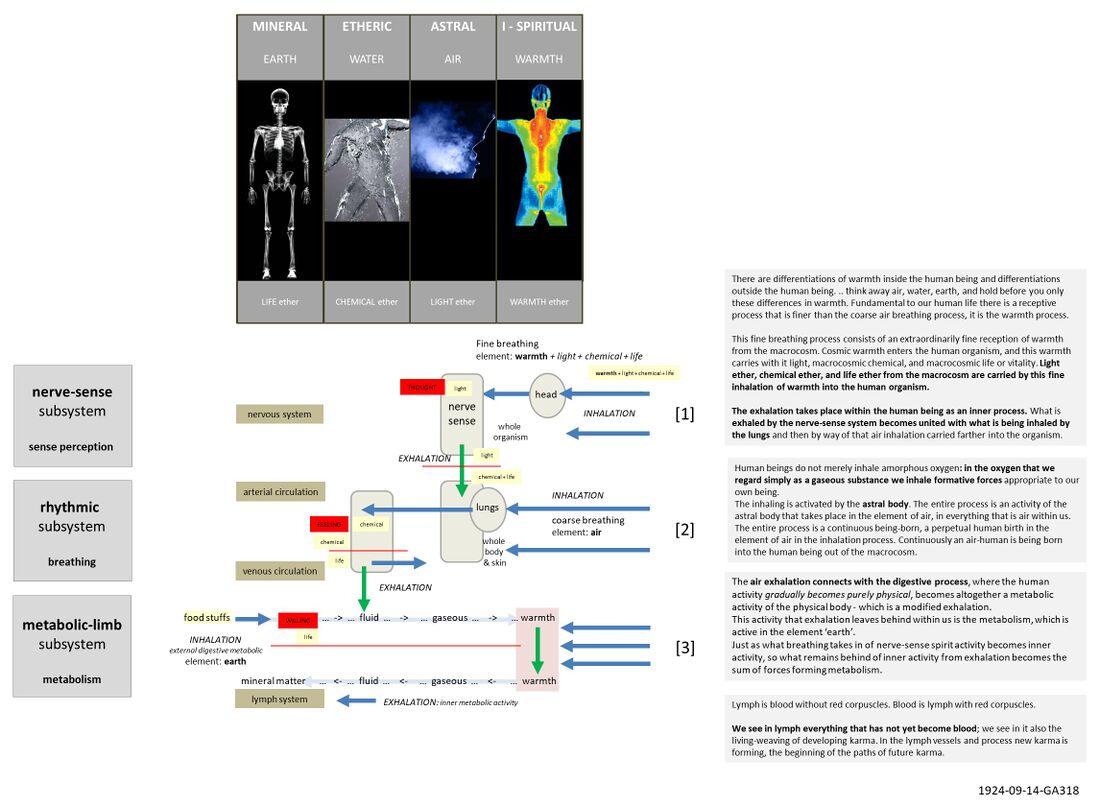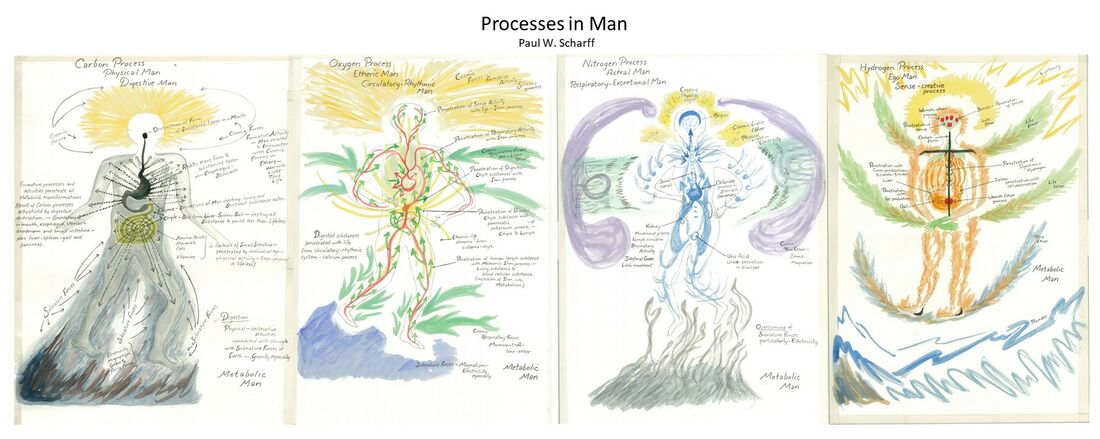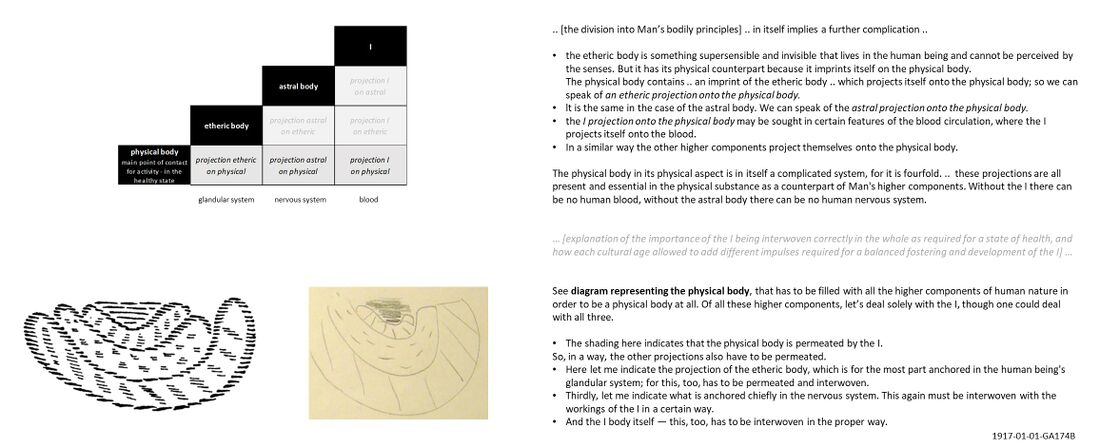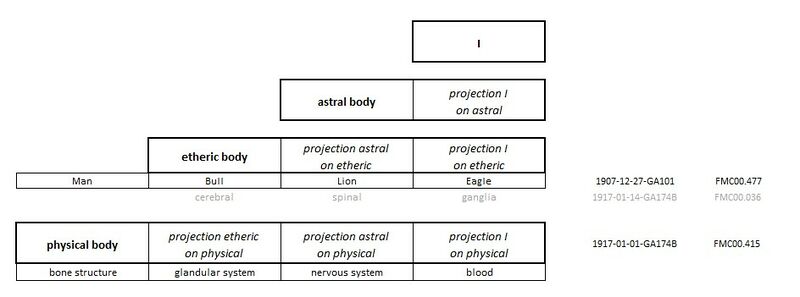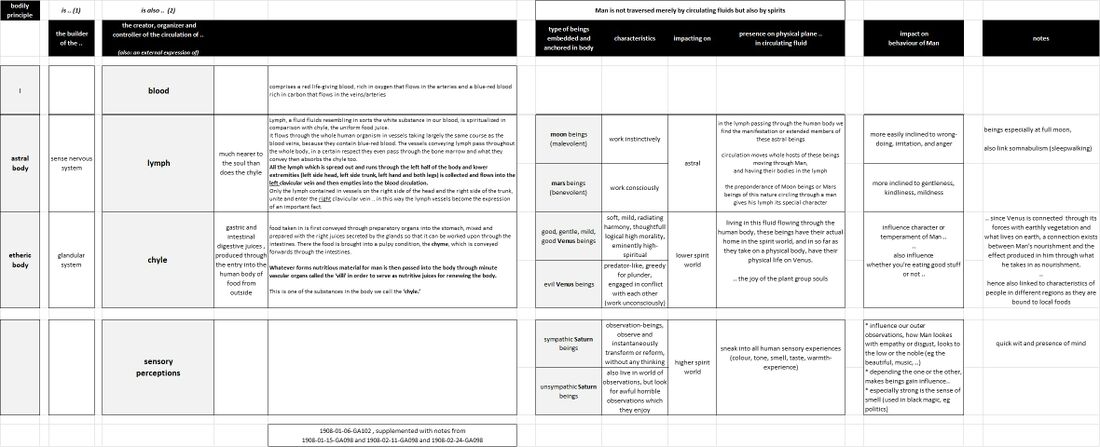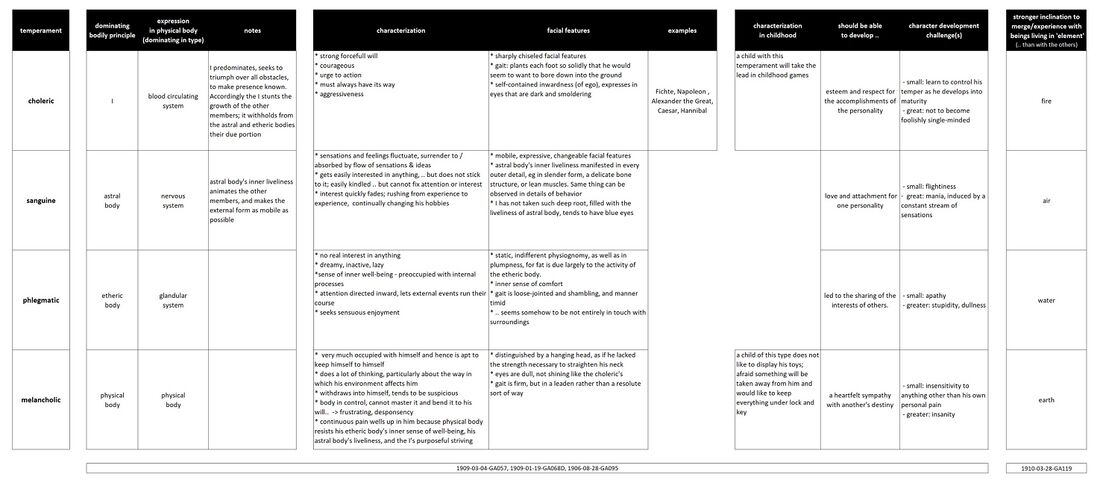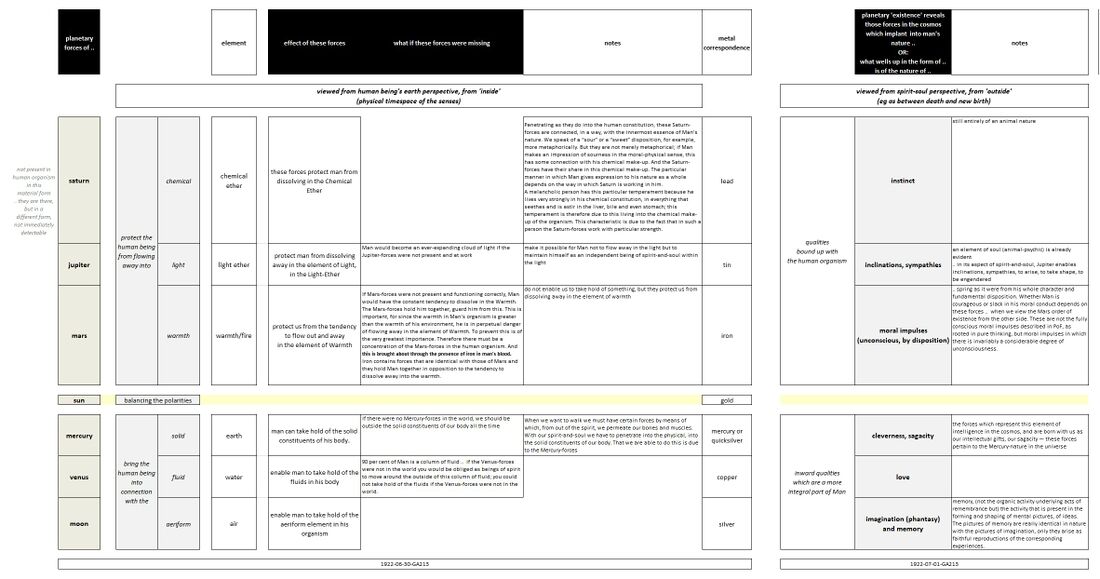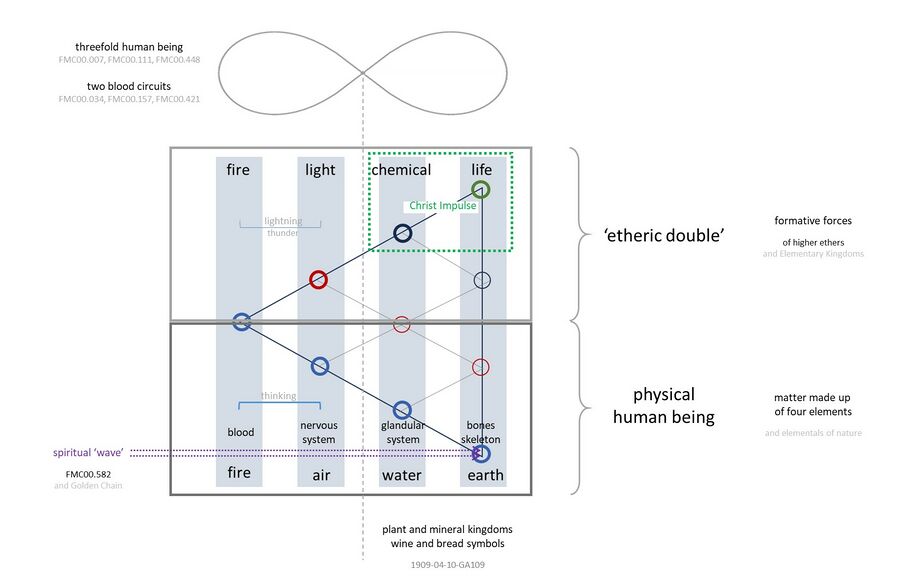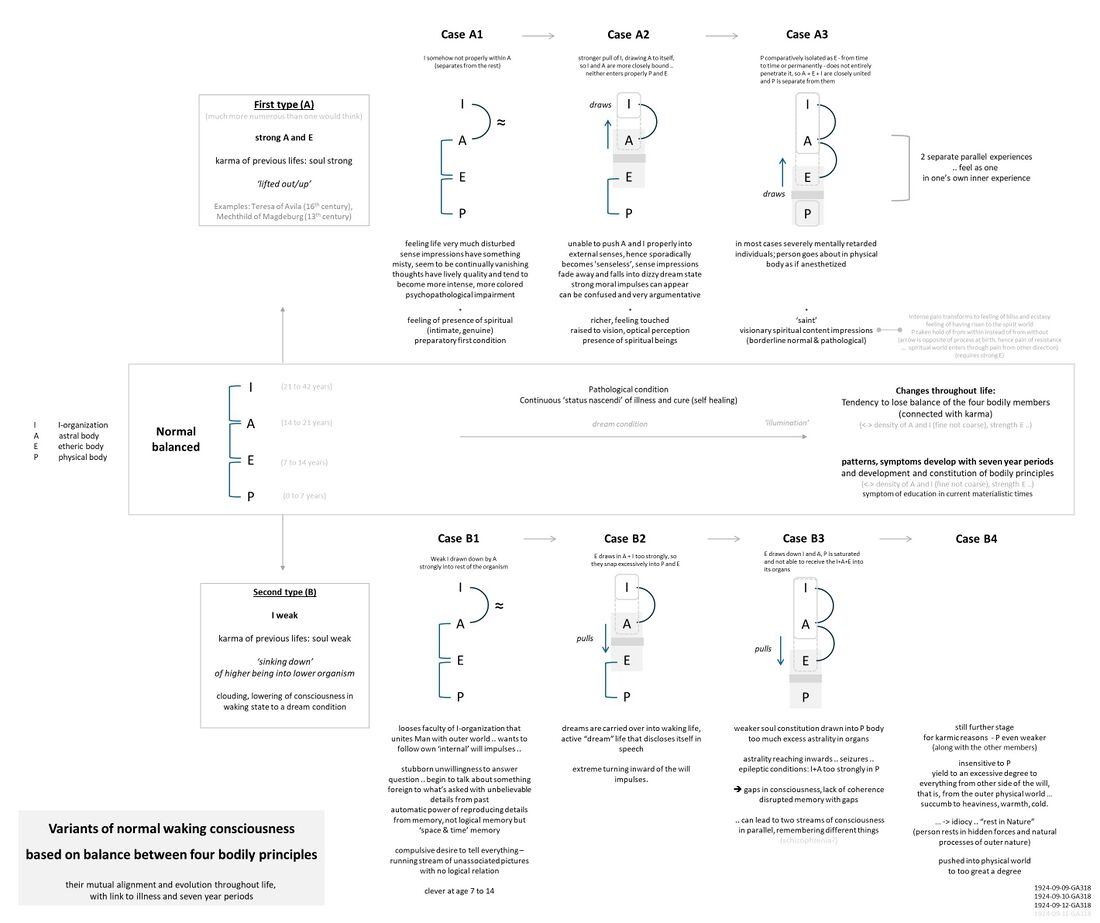Man: an integrated view
Man's constitution can be viewed from various perspectives:
- Man's bodily principles: the human physical, etheric and astral body, the human 'I' or threefold soul, and Man's higher triad. Of the latter, today the the fifth member or spirit-self is in development. From this basis a spiritual scientific physiology can be described
- Man as a threefold being with three 'functional subsystems': the nerve-sense, rhythmic, and metabolic-limb systems.
- connecting both: a Spiritual scientific physiology starting with all organs and components of Man's physical body.
The two first dimensions represent a matrix view to understand Man in the interrelationships between 'bodily principles' and 'functional subsystems'.
Man's main four bodily principles developed during previous planetary stages, and the three functional subsystems, together give a "4 by 3" view or mental framework structure to reason in. This matrix view to integrate the two above and not get locked in to narrow one-dimensional thinking.
Furthermore to be superimposed are:
- how the beings of spiritual hierarchies live in Man, see also Man and the spiritual hierarchies
- the rhythms and patterns of cosmic interactions or cosmic breathing, see also: Man and the macrocosmos
Finally there are the evolutionary aspects of Man past and future
- evolution in the previous planetary stages
- evolution of Man on Earth, the current planetary stage
Aspects
Three by four: linking the three subsystems and four bodily principles
- in the head-nerve subsystem, two independent developments of the physical-etheric on the one hand and the astral and I-organization on the other; in the metabolic-limb subsystem the four bodily principles are intimately bound up with one another; in the middle rhythmic subsystem the I-organisation and astral body alternately unite with the physical and etheric part, and loose themselves again. This alternating is seen in the inbreathing and arterial blood process (union) and outbreathing and venous blood process (loosening). (1925-GA026 - LT36 and LT37)
- human character is a result of how the human 'I' takes hold of the three lower bodily principles or members, see: Human character - the I and threefold soul
- the physical and etheric bodies are closely tied, just as the astral body and the human I. Both 'physical+etheric' and 'astral+human I' are connected through a 'silver cord' (also: 'astral matrix'), see Out of Body Experiences (OBE), at night the 'astral+human I' separate from the 'physical+etheric' bodies.
- changing relation between physical and etheric bodies (1919-04-05-GA190)
- inner connection between physical and etheric head has come to an end since 3th century BC
- progressive loosening of physical and etheric heart started around 1721 and physical heart will be entirely freed from its etheric part around 2100.
- later this will also be happening for other organs
different types
- three subsystems
- four elements and bodily principles appears in
- Human temperaments: every human being has one base temperament, with varying degrees of the other three mixed in
- Old Saturn Man, Old Sun Man, Old Moon Man is a presentation that is used in a number of lectures such as: 1915-06-03-GA162 (see below) and also 1915-06-22-GA157 and 1910-08-25-GA122 (Moon nature in Man). See also Schema FMC00.492 on Man and the spiritual hierarchies.
- for broader context and perspective of the segmentation and differentiation of humanity, see description to Schema FMC00.653
- the five human races, and link with the planetary influences and Atlantean oracles; see Schema FMC00.456 detailed with Schema FMC00.454, Schema FMC00.204 and Schema FMC00.186 on Human races
various
- inheritance is covered on
- at the intersection of the liquid/watery bodily principle and the rhythmic circulatory system
- the rhythmic system is usually thought of as mainly consisting of breath and blood circulation (in relation 1 breath to 4 pulses), however also lymph and chyle fluids circulate as astral and etheric counterparts (see Schema FMC00.155).
- Chyle, lymph blood are also called the three bodily humors as it existed in ancient Greece and the cultures before, and that based itself on liquids for health treatment.
- analogy of Man and plant
- Wood sap in plants (earthy-fluidic influence) corresponds to mucus in Man, the life sap of the plant (fluidic-airy influence) which circulates from the leaves, corresponds to the human blood (<-> human I), and the cambium of the plant (airy-warmth, influence of the stars) corresponds to the milk and the chyle (<-> etheric body) in the human being. (1923-10-31-GA351) - see Plant kingdom#1923-10-31-GA351 and Schema FMC00.616 and Schema FMC00.616A.
- see Schema FMC00.111 and link - in plant - with elementals of nature in Schema FMC00.009A, and - in Man - with fluids in Schema FMC00.155
Unbalances in the human bodily constitution and between Man's bodily principles
- see coverage on Illness ... and illustrations on Illness#Unbalances and Schema FMC00.338 that shows the effects of disorders in the human bodily constitution, if Man's bodily principles and I-organization are not in balanced cohesion (causing various forms of madness of the human character)
- Apparitions can appear when through certain special events the astral world can suddenly break in, eg as the result of a pathological event such as the loosening of the connection between the physical body and ether body, or between the ether body and the astral body (eg sun-stroke). More on the Apparitions page. See also the link with 'nature initiations' on Lightning#Note 1 - Events affecting state of consciousness and examples of lightning and sun-stroke.
- Examples:
- Sibyls were women whose life of soul lacked order and harmony, and through these disorders in the development of the human 'I' they got sibylline revelations or prophecies (between 8th century BC down to the middle ages) often containing great and sublime truths but whereby wisdom was confused and chaotic, fraught with all kinds of extravagance. (see: Three pre-MoG interventions of Christ#Sibyls)
- Some people have an abnormal make-up whereby the human astral body is not fully connected to the sensory organs, but whereby he is in a state of gentle sleep, making his full physical body a sense organ. The fact that the human I is partly freed from the astral body, allows to perceive metals, waters in the inner part of the Earth without digging holes, and also triggers clairvoyance (1923-01-07-GA220, see Dowsing#1923-01-07-GA220) Note the Dowsing topic page also has information about Alois Irlmaier as an illustration.
Inspirational quotes
The ability to think of the Universe as an organism depends on our learning to understand the hieroglyph of the organism we have before us. We must learn to perceive Man as a hieroglyph of the Universe, for he gives us the opportunity of seeing near at hand how different are above and below, left and right, before and behind. We must learn this first in Man, and we shall then find it in the Universe.
1921-04-02-GA204
what is the human organism? The human organism is a faithful copy of man's soul-spiritual nature.
Illustrations
Four by three
Schema FMC00.245 illustrates how the soul and spirit live in Man's bodily principles and I-organization. How the threefold soul activity and thinking feeling willing relates to the bodily organisms, and our contemporary waking consciousness is just a part of this. Man is actually asleep in part of his bodily constitution and functioning.
Schema FMC00.015A: shows Man as a threefold being and how the three main intake processes lie at the basis of Thinking, Feeling and Willing (TFW). It shows also how the subsystem processes are linked (green arrows), and how at each stage part of the etheric flows is stopped at the exhalation stage (red line).
Furthermore the schema allows to contemplate Man with an integrated view with the matrix linkeage between fourfold Man (re Man's bodily principles shown above, and see also four elements) and the Man as a threefold being (below and left, with three subsystems).
For the workings of the metabolic-limb system, which is not fully explained in the lecture 1924-GA318 lecture, take this schema together with Schema FMC00.412 on Metabolic-limb subsystem.
Schema FMC00.151: shows the four bodily principles of Man (physical, etheric, astral and 'I') over which are drawn the processes that take place in the three subsystems (sense-nerve, rhythmic, metabolic-limb), here from an angle of perspective of a Carbon, Oxygen, Nitrogen and Hydrogen process; see further coverage on Working of substances and their forces.
Projections
Schema FMC00.415 shows the human physical body as a structure that embeds and hosts all other Man's bodily principles, and hence has a specific organization for each of them as part or subset of the physical body. If a new principle is added, as the human 'I' in the current Earth planetary stage of evolution, then this new principle has to be interwoven in a balanced and correct way. This is done over the various epochs and cultural ages, and because it is so complex offers many ways for this development to go wrong (see eg the sixteen paths of perdition), as explained in the lectures of 1917-01-01-GA174B and 1917-01-14-GA174B. See also Schemas FMC00.036 and FMC00.338 on I-organization.
Note: The human physical body is extraordinarily complicated because the other bodily principles are 'stamped' onto the physical body. For example the projection of the astral on the physical body: the dynamic activity that weaves through the blood circulation and breathing system can only be understood if one thinks of it in musical forms, as there is a musical character to the formative forces that were poured into the skeletal system and then became active in a finer capacity in the breathing and circulation (1924-09-09-GA318).
Schema FMC00.415A is a variant that includes naming and mapping for the etheric body from 1917-12-27-GA101, as 'imprints' of astral group souls. The components of the nervous system are tentatively mapped on the basis of 1917-01-14-GA174B. This may not be a correct hence in grey, however it is still interesting to compare with Schema FMC00.036.
Schema FMC00.543: captures how 'the decaying spiritual wave that crashes into mineral matter' (1911-12-31-GA134, see Schema FMC00.582) gives rise to different types of matter depending on how Man's bodily principles are balanced (left), and how the spiritual structure was created by the different spiritual hierarchies and is now filled with physical matter as a result of the Luciferic infection (right).
For the description, see reference lecture extract The nature of atoms#1911-12-30-GA134.
Also compare with related schemas FMC00.514, FMC00.392, FMC00.492.
Schema FMC00.543A: is a simplified version of Schema FMC00.543 showing less detail, for ease of mapping and linking with other reference Schemas.
Schema FMC00.603: is a graphical illustration of the fact that Man's bodily principles work to a different extent in the three subsystems of Man as threefold being, as explained in 1921-04-11-GA313. The head or nerve-sense subsystem is essentially physical body only and thus the 'dying' part, opposite to which the metabolic-limb subsystem is the more spiritual coming into being part.
Various
bodily humors and temperaments
Schema FMC00.155 sketches how Man is traversed by spiritual beings from Moon, Mars, Venus in circulating lymph and chyle fluids, and how Saturn beings take their abode in Man's sensory perceptions. Chyle, lymph blood are also called the three bodily humors as it existed in ancient Greece and the cultures before, and that based itself on liquids for health treatment.
Schema FMC00.158 shows how the four temperaments are related to a dominant bodily principle, and find its expression in both external (physical and facial appearance and movement) and internal ways (character). See also Human character - the I and threefold soul.
other
Schema FMC00.005 shows how the various planetary forces or spiritual influences work in Man, and the correspondence with the Spectrum of elements and ethers as well as metals. Compare with Schema FMC00.297 to overlay Ahrimanic and Luciferic influences.
Schema FMC00.644: shows an alchemical view on the human being, illustrating various aspects related to Man and the Christ Impulse.
It is drawn against the background of Schema FMC00.556 with the Tetractys symbol and Rudolf Steiner's explanation of alchemy.
Below is 'tetrapolar' Man made up of the four elements of nature with the physical-mineral constitution of the four components of the physical body: blood (mineral substance with I living in the inner warmth), nervous system (astral), glandular system (etheric), and the bony system of the human skeleton (mineral, element earth) - see also Schema FMC00.415A. In purple is represented the spiritual wave (as per Schema FMC00.582, and explained on the Golden Chain). Bones are a symbol of expression of physical death, because this is where the spiritual energy wave runs dry (see also Schema FMC00.543 and Schema FMC00.543A). On the other hand, in blood the warmth is the carrier of all higher ethers - see also the 'mystery of silver' (o.a. Schema FMC00.285).
Above is the etheric double made up of the formative forces corresponding to the higher ethers, that hold together what is below - see also force substance representation and spectrum of elements and ethers.
Furthermore the Schema is also used to show other aspects:
- The vertical dotted line separates the plant and mineral kingdoms that Man will have to redeem, and the symbols of wine and bread used in the ancient Mysteries and the Last Supper in the monstrance as symbol of transubstantiation. The vertical dotted line also divides between Man's physical and etheric bodies (right) and Human I and astral body (left), both closely coupled and separating at the dotted line during sleep.
- Regarding the Christ Impulse:
- With the separation of Sun (and separation of Moon), the two highest ethers separated from Man and Earth, as explained in the lectures on the topic page Christ Module 11 - A new physics. With the Mystery of Golgotha, Christ merged with the Earth humanity and brought back these life-bringing forces for the spiritualization of humanity, represented in green on the Schema.
- Rudolf Steiner explains that, when Christ entered the body of Jesus of Nazareth, "a stupendous force shot through the entire body of Jesus of Nazareth and into the very bones" and the bones of Jesus changed through the penetration of this Christ force crumbling and assembling them again. For more info, see Baptism#Note 2 - No bone of Him shall be broken.
- human thinking is a process that takes place between the blood and nerves, and thoughts in the human being are what lightning and thunder are in the macrocosm (1909-04-10-GA109) .. which helps to understand why Rudolf Steiner coined the ('re-wiring') activity by the First Hierarchy in Man's nerve-sense organization with the term 'cosmic storm' (description in 1924-07-28-GA237 - see Transition between 4th and 14th century)
- the lemniscate above represents to the balanced subsystems in the Threefold human being and the two blood circuits.
Unbalances
Schema FMC00.647: shows variants of normal waking consciousness based on balance between four bodily principles, their mutual alignment and evolution throughout life, with links to illness and seven year periods. For the narrative, see lectures of 9 to 12 September 1924 in GA318. The blackboard drawing (BBD) of the first lecture is available as Schema FMC00.647A.
In these lectures, Rudolf Steiner shows how different psychopathological conditions can develop based on an individual's karma, but also due to the typical consequences of modern education (going into the seven year phases in 1924-09-11-GA318). A link can be made with statements predicting future epidemics of mental illnesses.
The upper Case A is the pattern typical for mystics such as Teresa of Avila, Mechthild of Magdeburg, and many others.
Note: Also building on this picture, additionally in 1924-09-13-GA318 the example of Ferdinand Raimund is given as someone who developed both the upper and lower patterns (A and B), with a karmically predisposed breathing system as a carrier for anxiety elementals (demons), that pushed karma in a certain direction (Raimund committed suicide).
See also Schema FMC00.338 and Man: an integrated view#Unbalances in the human bodily constitution and between Man's bodily principles.
Lecture coverage and references
Overview
The integration between the various perspectives is embedded in the broad coverage of Man - the human being, and there is no specific lecture cycle that covers the linking of these various perspective dimensions. However, in a number of lectures this is the central theme.
Examples are:
- 1923-02-11-GA221 is called 'the invisible man in us'
- 1924-09-14-GA318 takes breathing as the start, but links the inputs from the three subsystems (sensory inputs, breathing air in/out, and taking in food-stuffs) to the higher ethers and the inner processes in Man, linking it to thinking, feeling, willing (TFW).
Reference extracts
1906-10-25-GA055
The ether body transforms inorganic substances into living fluids;
the astral body transforms living substance into sensitive substance.
But — and of this please take special note — a being composed of no more than the three bodies is only capable of sensing itself. It is only aware of its own life processes; its existence is confined within the boundaries of its own being.
This fact is most interesting, and it is important to keep it in mind.
1915-06-03-GA162
for long extract see: Transition between Earth and Future Jupiter#1915-06-03-GA162
(SWCC)
.. human evolution has arrived at the Earth stage only after passing through previous stages, and the Earth stage was preceded by the Old Moon stage .. the former Old Moon stage is preserved in a later stage, is active therein; we can put it this way: that we are Earth men, but that we in a certain sense, carry the Old Moon man in us. We have developed from the Old Moon stage, yet the Old Moon-man lives in us, he is part of us. We could show this in diagrammatic form ... or, we can say: we carry with us the Earth man, but the Earth man surrounds the Old Moon man. We can proceed further, that the Old Moon man also encloses the Old Sun man, and the Old Sun man in turn encloses the Old Saturn man; so we carry within us, in addition to the Old Moon man, the Old Sun man and Old Saturn man.
We must, of course, not imagine that this diagram in any sense reproduces the truth. In reality, the Old Moon man does not sit inside as if he were surrounded by a shell; but if we wish to imagine the reality related to this ‘dual’ man, the matter stands thus, for example:
- that, which in a specific sense, belongs to the Earth, we would have to imagine as residing chiefly in the trunk, the lower and upper limbs and as far as the throat region.
- And if trying to imagine the Old Moon man we must visualize him as the surmounting head;
- the Old Sun man has certain — already disintegrating organs in the head,
- and the Old Saturn man has head organs now scarcely discernable.
1919-04-05-GA190
changing relation between physical and etheric bodies:
- inner connection between physical and etheric head has come to an end since 3th century BC
- progressive loosening of physical and etheric heart started around 1721 and physical heart will be entirely freed from its etheric part around 2100.
- Later this will also be happening for other organs.
see: Current fifth cultural age#1919-04-05-GA190
1921-04-02-GA204
1924-07-21-GA319
everything that constitutes the etheric body is intimately bound up with the metabolic and limb system, everything that constitutes the astral body is bound up with the rhythmic system;
Unbalances
1920-10-09-GA314
about balance of the three subsystems, see Schema FMC00.669
This morning I directed your attention to the fact that the life of the human organism consists of the nerve-sense system—the head system—working oppositely to the metabolic-limb system; these two are then balanced by the rhythmic system.
All breakdown processes, the completely necessary breakdown processes of the nerve-sense system, are continuously brought into harmony and exchange with the upbuilding processes of the metabolic-limb system.
You can imagine (and this can be verified in detail) that because the two systems of the human organism work in a thoroughly opposite way, they also work upon one another. Thus what goes on in the details of the metabolic-limb system, for example, should not be influenced too strongly from the head system, bypassing the rhythmic system; when this happens an activity suitable only to the head system works its way into the metabolic limb system.
If we adequately penetrate what we are concerned with here, we will come to understand how such intrusions of one system upon the other can take place.
- [metabolic-limb >> nerve-sense]
- It will be understood, in other words, how the head system, the nerve-sense system (in which there must also be metabolic processes, as I have explained to you), can occasionally be overcome by metabolic processes that make the head system resemble the metabolic-limb system inwardly and functionally.
- [nerve-sense >> metabolic-limb]
- The reverse can also take place, because the same functional system that is normally active in the head is also active in the metabolic-limb system, though in a subordinate way. Occasionally this activity can get the upper hand, can become too intense in the metabolic-limb system, where it should only reach a certain level, having its actual significance in the head.
- This is possible, in other words, because the nerve-sense activity that is also present in the metabolic-limb system strongly impregnates the metabolic-limb system with head activity, which thus becomes predominant in the abdomen, for example. Said in a better way, it becomes an activity whose intensity is too great. Then what should normally take place as breakdown processes only in the nerve-sense system will take place in the abdominal organs. Of course it will take on another form in the abdominal system, but it will nevertheless cause mischief there. In fact, by looking in this way into the organization of human nature, we can see in the phenomenon I have just described the development of a serious human illness, namely, typhus abdominalis. The manifestations of typhus may certainly be studied empirically, but they can be understood and placed within the entire human organization only if one is able to penetrate the human being in this way from the standpoint of a rational medicine, if I may use this Goethean designation.
1923-08-28-GA319
lecture title: Polarities in Health, Illness and Therapy
see Schema FMC00.669
Now both these systems, the first and the third, the nerve-sense system and the metabolic-limb system, are placed polarically opposite each other. What the one creates destroys the other. What destroys the other is created by the one. They thus work in completely opposite ways. And the middle system, the rhythmic system, establishes the connection between the two. There is a kind of vacillation, oscillation, between them, so that a harmony can always exist between the destruction of the one system and the construction of the other system. If, for example, we look at the metabolic system, we recognize that it naturally works with its greatest intensity in the lower body of the human being; but that which goes on within the human abdomen, or the lower body, must call forth the polar opposite activity in the head, in the nerve-sense system, when the person is healthy.
Imagine now that the activity actually inherent in the human digestive system intensifies so much that it extends right up to the nerve-sense system, so that the activity which should actually remain in the metabolic-limb system reaches over to the nerve-sense system. Then you have a natural process, so to speak, but you can see immediately how that natural process becomes an abnormal one. It should remain in the metabolic system, but breaks through, so to speak, upwards into the nerve-sense system.
That results then in the various forms of the illness treated by medicine today as insignificant, but not treated in that way by a large part of humanity because these various forms of illness are known everywhere. What develops is known as the various forms of migraine. In order to understand migraine in its various forms we must comprehend this process which ought only to take place in the metabolic system but which breaks through to the nerve-sense system so that the nerves and senses are so affected that the metabolism shoots into them instead of remaining in its own place.
The reverse can also take place. The process which ought to be most intensive in the nerve-sense system, and which is completely opposite to the metabolic process, can in a certain sense also break through to the metabolic system. Consequently an enhanced nerve-sense process takes place in the metabolic system where normally a merely subordinated nerve-sense process should be active. Thus what belongs to the head, as it were, breaks through into the lower body. If this happens then the dangerous illness develops which is known as typhoid fever.1
Thus we can see how a fundamental understanding of this three-fold human being makes it possible for us to understand how a process of illness develops out of a healthy process. If our head, with its nerve-sense system, were not organized as it is, then we could never have typhoid fever. If our lower body were not organized as it is, we could never have migraine. The head activity should remain in the head, the lower body activity in the lower body. If they break through then such forms of illness develop.
And just as we can point to two especially characteristic forms of illness, so can we point to other forms of illness which always develop when an activity which belongs to one organ system asserts itself in another place, in another organ system.
If one proceeds only anatomically one merely observes the status of the smallest parts in the tissues of the organism. But one does not see the working of polar opposite activities. When studying the nerve cell you can only study that its organization is opposite to that of the liver cell, for example. If, however, you were able to look into the totality of the organism in such a way that it appears to you in its three-foldness, then you will also notice how the nerve cell is a cell which continually tends to dissolve, which continually tends to be broken down if it is healthy: and how a liver cell is something which continually tends to be built up if it is healthy. Those are polar activities. They work in the right way upon one another if they are appropriately distributed in the organism; they work incorrectly within one another if they penetrate into one another.
The rhythmic system is in the middle and always strives to create the balance between the two opposed polar activities of the nerve-sense system and the metabolic-limb system.
...
This antimony process existing in the human organism is opposed in a polar way to another process. It is opposed to that process which arises where the plastically active forces, for example, the cell-forming forces occur. These are the forces which round out the cells, which form the cellular substance of the human organism. I would like to call these forces, because they are primarily contained in protein substance, the albuminizing forces. Thus we have in the human organism the forces which we find outside in human nature in antimony if we subject antimony, for example, to combustion, and bring about an antimony mirror. In addition we also have the opposing forces active, the albuminizing forces, which immobilize, which take away the antimonizing forces.
These two force systems, albuminizing and antimonizing, work against one another in such a way that they must be in a certain state of equilibrium in the human organism. One must now recognize that the process which I have described to you before in principle, and which lies at the basis of abdominal typhus, is essentially based on a disturbance of the balance between these two force systems.
In order to look properly into the human organism one must be able to take recourse to that which I have described to you from the most varied—although not medical—points of view in these morning lectures.
In them we have seen how man has not merely his physical body, but also an etheric body—a body of formative forces, an astral and an ego organization. And just yesterday I was able to explain to you how there is an intimate connection on the one hand between the physical body and the formative force body, and on the other, between the ego and the astral body. There is a looser connection between the astral body and the formative force body, for they separate every night.
This interconnection, which consists of a working into one another of the forces of the astral and etheric bodies, is radically disturbed in typhoid fever. In this illness the astral body becomes weak and is unable to work with a corresponding intensity into the physical body because it works for itself thereby bringing about that excess which presses downward, so to speak, the nerve-sense organization, which is primarily subject to the astral body. Instead of transforming itself into metabolic activity, it remains active as astral activity. The astral body works for itself. It does not work properly into the etheric body. The consequences are the symptoms of illness which give us the symptomatology of typhus.
Now that which occurs as antimony is active in such a way that antimony denies its mineral nature. It gets crystalline threads, so that even the antimony mirror, wherever it deposits, appears like ice-flowers in the window, thereby showing the inner force of crystallization as in nature. This force of crystallization, which becomes active in antimony, if it is properly incorporated into a remedy and introduced into the organism, works in such a way that it supports this organism enabling it to insert its astral body with its forces into the etheric body in the right way, so that it can bring these bodies again into the right connection.
With antimony prepared in a proper way into a remedy we support that process which opposes the typhus process. And just with this antimony remedy, to which other substances are added, one can battle against the illness by stimulating and supporting processes in the organism so that it unfolds its own, I would like to say, antimonizing force which has as its goal to call forth the proper rhythm in the working together of astral body and etheric body. Other substances must be mixed in to establish a proper connection to the organism depending on whether an illness takes one or another course.
Thus an anthroposophical consideration leads to the recognition of a relationship between what is active in the objects of nature, as I have shown you with the example of antimony, and that which is active within the human organism. You will be able to follow up this albuminizing, this plastically rounding force, and the other force which works linearly right into the germ cell.
Discussion
Related pages
- Man - the human being
- Spiritual scientific physiology
- Worldview Spiritual Science
- Human temperaments
- Human character - the I and threefold soul
References and further reading
- Otto Julius Hartmann:
- Erde und Kosmos im Leben des Menschen (1938, 1950)
- Der Mensch als Selbstgestalter seines Schicksals (1939, 1984)
- Anthroposophie. Einführung in des Verständnis des Menschen-Wesens (1950)
- Albert Schmelzer, Jan Deschepper: 'Antroposofische menskunde begrijpen' (14 essays) (2021)


